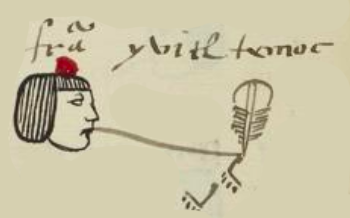Ihuitl Temoc (MH838v)
This black-line drawing of the simplex glyph for the personal name Ihuitl Temoc (“The Feather Descended”) is attested here as a man’s name. The glyph shows a frontal view of a vertical feather (ihuitl), where the lower half consists of downy barbs, and the upper half is a white vane. The lower tip of the calamus nearly touches the top of two alternating footprints (which have the semantic meaning of the verb temo, to descent). The footprints appear in a bird’s eye view. The preterit tense (-c) is not shown visually.
Stephanie Wood
There was a famous don Diego Luis Moctezuma Ihuitl Temoc (also spelled Ihuitemotzin). Perhaps this Alonso is named for don Diego or another illustrious person who shared this name. The gloss for this name has some separation between the two words. Sometimes these elements are run together in the gloss. See below for some other examples of glyphs for Ihuitl Temoc. One has the feather with the calamus upward, and one employs down feathers instead of wing feathers. This latter example, from the Codex Vergara (f. 9v) has an added stone (tetl) as a phonetic complement.
Stephanie Wood
fraco yvitl temoc
Francisco Ihuitl Temoc
Stephanie Wood
1560
Jeff Haskett-Wood
plumas descendientes, nombres de hombres

ihui(tl), feather, https://nahuatl.wired-humanities.org/content/ihuitl
temo, to descend, https://nahuatl.wired-humanities.org/content/temo
La Pluma Descendió
Stephanie Wood
Matrícula de Huexotzinco, folio 838v, World Digital Library, https://www.loc.gov/resource/gdcwdl.wdl_15282/?sp=751&st=image.
This manuscript is hosted by the Library of Congress and the World Digital Library; used here with the Creative Commons, “Attribution-NonCommercial-ShareAlike 3.0 License” (CC-BY-NC-SAq 3.0).





